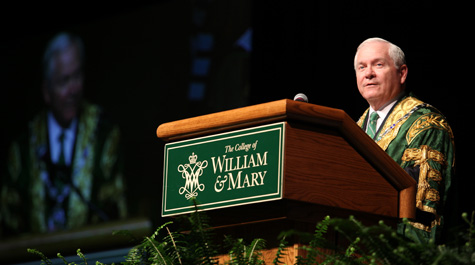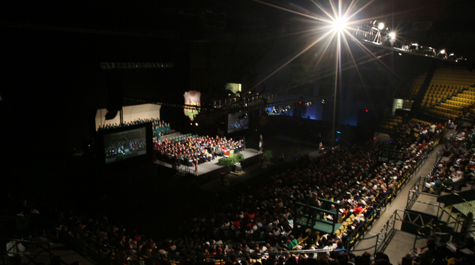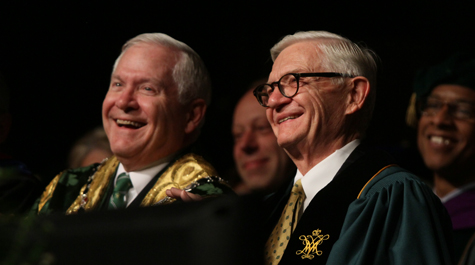Murray: James Monroe a model for today's leaders
As William & Mary celebrated its 322-year history Friday, James B. Murray Jr. reminded the College community about an often overlooked but key figure in the early development of the United States: President James Monroe, W&M Class of 1776.
“While Monroe may not be credited as a creator of this nation, he should be credited with being a builder of this nation,” Murray, J.D. '74, LL.D. '00, told more than 3,000 people gathered in William & Mary Hall for the 2015 Charter Day ceremony.
{{youtube:medium:left|ILxI95auh7Q, Watch the full ceremony}}
The annual event marks the day on which William & Mary received its royal charter in 1693. Murray, a venture capitalist and former Rector of the College, served as the keynote speaker at the event, in which several members of the campus community and friends of the university were honored. Former Virginia Commonwealth University Provost Grace E. Harris and former William & Mary President Thomas A. Graves both received honorary degrees. William & Mary Chancellor and former U.S. Secretary of Defense Robert M. Gates ’65 also offered welcoming remarks at the ceremony, emphasizing the importance of scholarships, like the one that made it possible for him to attend William & Mary.
“It was an individual, just one in the pantheon of William & Mary people, whose generosity helped make my William & Mary experience possible,” he said. “And it’s individuals -- you and me -- who can ensure that a William & Mary education is within reach for this generation of world-changing students.
“Scholarships, like the one I received, link one generation of William & Mary to another. They make a crucial difference today, and they will for all time coming. Each of us should consider how we can make a difference at William & Mary through scholarships.”
A legacy for today
Although Monroe is celebrated on the William & Mary campus, with his name appearing on Monroe Hall and the Monroe Scholars Program, many at the College – and beyond – are unaware of his full impact on the United States, Murray said.
“We all revere the history of the College. We feel the pride of it in our bones, yet our appreciation for the roots of that pride is often episodic. … too often we overlook the greater glory of having educated one of America’s greatest presidents,” he said.
{{youtube:medium:left|uducU0gkHHU, Murray's remarks}}
In order to realize Monroe’s full impact on the country, one need only to ask, ‘What if?’ Murray mused. What if Monroe hadn’t sized the opportunity to buy Louisiana or obtain Florida or establish boundaries with Mexico or Canada? What if he, as secretary of state, hadn’t spoken up in a Cabinet meeting during the War of 1812, after much of Washington D.C. was burned and the President James Madison’s advisers called for surrender?
“The United States might be no more than a medium sized, 13-precinct country appended to the eastern edge of multi-nation continent,” said Murray. “Instead of a vast nation of striving entrepreneurs, might we have been a little nation of shopkeepers, mill workers and serfs?”
“Occasionally we need reminding that so much we take for granted about our nation today was far from assured during those early years. It took a nation-building president to assure this nation.”
William & Mary played a large part in forming that nation-building president, said Murray.
“It began right here, where he met with demanding professors, borrowed books on government and philosophy from Thomas Jefferson and first met the legal scholar George Wythe,” he said. “William & Mary helped make a leader out of this young farmer.”
Today, both the nation and the world can learn from the life and legacy of Monroe, and William & Mary is playing a part in making that legacy known, Murray noted, with support for Monroe’s historic home, Ash Lawn-Highland initiatives like the Monroe Revival and Presidential Precinct.
“William & Mary must forge its place in the shrinking, interconnected world where the threat to liberty is great, immeasurably dispersed and instantaneous,” said Murray. “We must send forth our graduates using James Monroe as our model to, in his words, defend the holy cause of mankind.”
Awards and recognition
The annual Thomas Jefferson Awards were also presented at the event. David Aday, professor of sociology and community studies, was presented the Thomas Jefferson Award, and Hispanic Studies Professor John Riofrio received the Thomas Jefferson Teaching Award.
{{youtube:medium:left|FAJ-8seM7ug, Aday's's remarks}}
Two students also received awards. Will Bergan ’15 received the Thomas Jefferson Prize in Natural Philosophy, and Marge Lobeck ’15 accepted the Monroe Prize in Civic Leadership.
Additionally, four alumni – this year’s Alumni Medallion recipients – were recognized at the ceremony: Elizabeth Anderson ’62, Virginia McLaughlin ’71, Martin Walsh ’66 and Russell Brown ’74, who passed away last year.
{{youtube:medium:left|9JIUjj3yJLw, Riofrio's remarks}}
Several students read excerpts from the charter at the event, and Heein Choi ’17, served as the event’s student speaker, reflecting on the university’s charter.
“Much like the evolving and adapting royal charter, our definition of William & Mary will change and adapt as time passes,” he said. “With every student that recites the honor code in Wren Chapel, William & Mary adds a new layer to its expanding definition. William & Mary is defined by the people on this campus.”
Just starting to roll
Three hundred and twenty-two is “really old” by human standards, but great universities are often just getting in gear by the time they reach that birthday, said President Taylor Reveley in closing the ceremony.
Most universities are “remarkably durable creations,” said Reveley, “especially if they have been tempered by the fires of war and privation and, like the phoenix, have risen from the ashes. William & Mary has been so tempered.”
{{youtube:medium:left|SphX4FgdYKY, Reveley's remarks}}
Throughout its history, William & Mary has endured wars, competition and lean economic times, but the College has proven itself to be to “nigh unto indestructible,” said Reveley.
Current students will live to see William & Mary rise to extraordinary heights in the 21st century, sustained in part by their commitment to it, the president said.
“William & Mary -- born on February 8, 1693 –will be 322 years old this Sunday, and it’s just beginning to roll,” he said.



























